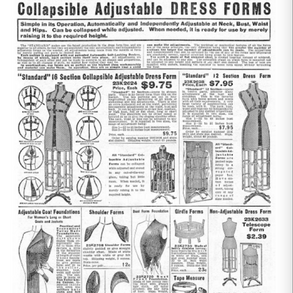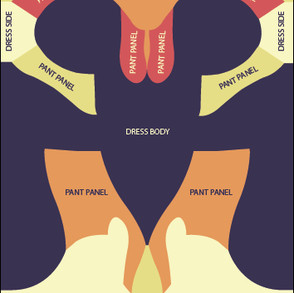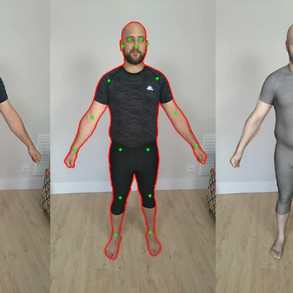
Pattern cutting &
Sustainability
Oct 21, 2022
Pattern cutting techniques
Production & Sustainability
- Pattern cutting History
- Blocks and anthropometric data used
- Innovative pattern cutting
- Zero waste as a sustainable or creative process



Pattern Drafting History - Pre industrial methodology.
We looked at Japanese Kimono: The structure of the pattern is due to the kind of material used. It was extremely expensive, so they wanted to utilize every inch of it.
Historical costume in more western areas were also already leaning towards zero waste concepts with dropped crotch style pants, and kilts. Garments were passed down from parents to children, re-utilized, re-cut… They could not afford any waste.
There was no idea of “measurements”, “tolerance”, or “mass manufacturing”...






Standardization and drafting
The textile industry was one of the big drivers of innovation. Apparel was made to fit every customer. Tailoring became a well known profession, and goes back into history with methods passed down over generations. Standardization is based on the technological advances of garments.
Let's keep in mind that corset & tailoring were all about shaping the body, distorting, often even harming it.
When tracing a garment, one can use Pattern drafting or Draping.
Made to measure is essentially the same as draping. It is great for apparel with movements and flow, but can be challenging when trying to have consistency or standardization.
The dress form is a major element of draping, and has a very strong History itself. It's critical to note that the dress forms are already dressed in the undergarments (this is what their shape is based on, assuming the person will wear undergarments). The posture/ Structure of the body shape is not “natural".
To make some progress on that front, Alvanon created an extensive 3D library. Their bust forms are based on 3D scanned body types. Still wearing underwear, however.
One big challenge is the gap between thighs. We have soft tissue! It’s malleable. But you need gaps between limbs to work on draping... as a result, mannequins are never fully realistic.
Manufacturers have started to use different types of foam on mannequins: it’s a little bit squishier. Arguably, that gap in dummy "realistic" aspect doesn’t need to be covered because it then becomes cheaper to use a real person.
Posture is also an issue. We don’t stand completely upright any more. We slouch, and are always looking down on technologic pieces, as such, the posture of the bust forms we use should be updated accordingly.
READY TO WEAR.
North American mens measurement chart is based on Military Uniforms from the 1800's: they were malnourished, different body type, different body tone… There is a chart with how RTW fits, compared to how people fit on spectrum, almost no one coincides.
There can't be a worldwide standard in sizing: Sizing, standards and pattern methodology vary from country to country depending on the population of these countries : both based on a different body type per population and a different aesthetic.
STANDARD SIZE
ASTM “ASTM International, formerly known as American Society for Testing and Materials, is an international standards organization that develops and publishes voluntary consensus technical standards for a wide range of materials, products, systems, and services.”
US dept. Of Agriculture - Bureau of Human Nutrition and Home Economics: Division of Textiles and Clothing (1941).
The silhouette is incredibly hourglass, yet tiny. Feminine ideals vary extremely fast and often, it's hard to keep up with how a female body should look like. Dior influenced the ideal of women after the war to make them look weak and needing assistance again.
1955 Voluntary standard. NIST
Over the years, body types and stature have changed so much that looking at body types is necessary to function as a designer nowadays. To try to solve this problem, the CAESAR STUDY: a 18 to 65 - 3D anthropometry database has been started a few years back. All bodies are real world examples of people, scanned in consistent garment standards. It shows the differences in proportions and sizes. You can look up at all the body measurements of a 32DD for example. This dataset is extremely expensive (100,000. 00 USD +/-) but also incredibly valuable for the world of apparel design nowadays.






Zero waste : innovative vs sustainable potential
This lecture pointed out that Zero waste is not always sustainable. Sometimes it’s more sustainable to cut through and STILL use less fabric, (including cut waste).
In apparel manufacturing, efficiency is usually considered with 15% or less loss in the cut fabric.
Here are a few interesting designers:
- TIMO RISSANEN: study on waste (CUT & SAW, A-POC, Fully Fashioned)
- DAVID TELFER: minimum Seams, making a few cuts in the fabric, sawing it and having a full design come out of it.
- ZANDRA RHODES
-Usually zero waste, tend to fall away from the body, be looser silhouettes, more ease more inclusive of many sizes/ body shapes
- HOLLY MCQUILLAN: Print driven design. She takes patterns and looks at how she can change them into zero waste. …sometimes, zero waste needs sacrificing fit and “comfort” which can be complex for the customer.
https://hollymcquillan.com/portfolio/twinset/
- JULIAN ROBERTS: Uses subtraction Cutting, utilizing all the fabric but thinking about pattern cutting and spatial awareness in a different way.
- SHINGO SATO It is wearable art, he's trying to look at how to transform and find ways to move away from typical seam placements.
I personally believe that 3 scanning and digitalization can lead us to doing great things in terms of comfort and performance in the apparel industry.


